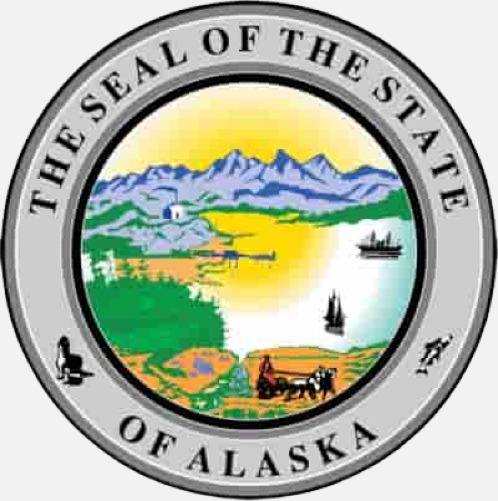 State Flag |  State Seal |
Alaska is a U.S. state situated in the northwest extremity of the North American continent. Bordering the state to the east is Yukon, a Canadian territory, and the Canadian province of British Columbia, the Arctic Ocean to the north, and the Pacific Ocean to the west and south, with Russia further west across the Bering Strait.
- ABBREVIATION: AK
- NICKNAME: The Last Frontier
- POPULATION: 740,133 (2024 est.)
- CAPITAL: Juneau
- STATE BIRD: Willow Ptarmigan
- STATE FLOWER: Forget Me Not
- AREA: 663,268 sq. mi.
- TIME ZONE: East of 169° 30′ Alaska: UTC -9/-8 – West of 169° 30′ Aleutian: UTC -10/-9
- ENTERED UNION: Jan. 3rd, 1959
- ALTITUDE: High, 20,320 ft. Mount McKinley (Denali)
- CLIMATE: On the Alaska panhandle, relatively mild, with heavy rain; elsewhere, extremely cold winters inland, with cool summers, light rain.
Partly because of its forbidding size (it would almost touch all 4 boundaries if superimposed upon the rest of the continental United States) Alaska remains a largely untapped frontier region.
Most of its northern frozen tundra, fog-enshrouded volcanic islands and moist panhandle are still public lands. Salmon, timber and gold are important resources of income. But all 3 are overshadowed by the size of federal expenditures on the areas defense.
A high percentage of Alaska’s residence are in military uniform, in military posts scattered across the state-and for good reason. In the age of jet planes and intercontinental missiles, Fairbanks lies closer to Moscow than any other major American city. Only the Bering Straight, sometimes solid with ice during the winter, separates Alaska from Soviet Siberia.

Alaska’s Augustine Volcano erupting on 1/12/06
Alaska is a land of promise. the last truly undeveloped region of the U.S. Here lie, still awaiting exploitation, rich petroleum reserves, as well as extensive gold and coal deposits. The land’s promise, moreover, is not far from reality, for a great asset of the nation’s second youngest state is its people and their pride. “When I grow up”, children are often heard to say, “I’m going to do something-for Alaska”.
FUN FACTS:
- Twice as much earth was moved to build the Tennessee-Tombigbee Waterway than during the construction of the Panama Canal.
- In 1955 Alabama became the first state to have a state-owned television station.
- The first rocket that put humans on the moon was built by workers in Alabama.
- Dismals Canyon, a few miles south of Russellville, has natural bridges, waterfalls, and one of the few stands of virgin forest east of the Mississippi River. Aaron Burr used the area as a hideout for several months.
- Alabama in 1861 was the first to design and fly the Confederate Flag.
- George Washington Carver, a freed slave who helped revolutionize the economy of the South through his experiments with peanuts, soybeans, cotton, and sweet potatoes, was the director of agricultural research at the Tuskegee Institute.
History:
Alaska’s history is a fascinating story of ancient cultures, international trade, territorial struggles, and environmental extremes. Long before it became the 49th state of the United States, Alaska was home to Indigenous peoples who lived in harmony with its vast and often harsh landscape.
The Inupiat, Yupik, Aleut, Tlingit, and other Native groups developed rich cultures based on fishing, hunting, and trade, thriving in coastal, tundra, and forest environments for thousands of years.
The first Europeans to reach Alaska were Russians, who arrived in the mid-1700s in search of valuable sea otter pelts. In 1784, the first permanent Russian settlement was established on Kodiak Island.
Eventually, the Russians extended their presence across southern Alaska, founding the city of Sitka in 1804, which became the capital of Russian America. Russian control was largely focused on fur trading and missionary work, but the territory remained difficult to manage due to its remote location and challenging conditions.
In 1867, Russia sold Alaska to the United States for $7.2 million—a transaction often mocked at the time as “Seward’s Folly,” named after Secretary of State William H. Seward, who negotiated the deal. Critics saw Alaska as a frozen wilderness with little value. However, this view would soon change.
After the U.S. took control, military and administrative presence was minimal. Alaska’s strategic importance began to grow in the late 19th century, especially after gold was discovered. The Klondike Gold Rush of 1896–1899 drew thousands of prospectors through Alaska on their way to the Yukon, leading to the establishment of new towns and boosting the territory’s economy. The Nome and Fairbanks gold rushes further increased settlement and investment.
During World War II, Alaska gained military importance due to its proximity to Asia. The Japanese occupied the Aleutian Islands of Attu and Kiska in 1942, marking the only U.S. territory occupied by enemy forces during the war. This led to increased American military development in the region and solidified Alaska’s role in national defense.
Alaska became a U.S. territory in 1912 but did not achieve statehood until January 3, 1959, becoming the 49th state. Statehood brought political representation, increased federal investment, and the development of key infrastructure.
The discovery of oil at Prudhoe Bay in 1968 transformed Alaska’s economy. The completion of the Trans-Alaska Pipeline in 1977 allowed oil to be transported from the Arctic to the southern port of Valdez, creating jobs and funding the Alaska Permanent Fund, which provides annual dividends to residents from oil revenues.
Today, Alaska is known for its breathtaking natural beauty, diverse wildlife, and cultural richness. While it faces modern challenges such as climate change and economic diversification, it continues to honor its Indigenous heritage and strategic role in energy and national defense.
From ancient traditions to contemporary innovation, Alaska’s history is a story of survival, opportunity, and the enduring human spirit in one of the most extraordinary places on Earth.